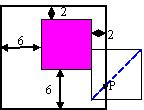Skip over navigation

The black line shows the locus of P as the white square slides around the pink square.
The locus is a square of side 16cm, and hence P moves through a distance of 64cm.



Or search by topic
Number and algebra
Geometry and measure
Probability and statistics
Working mathematically
Advanced mathematics
For younger learners
Pink and White
Age 14 to 16
ShortChallenge Level 





- Problem
- Solutions
The black line shows the locus of P as the white square slides around the pink square.
The locus is a square of side 16cm, and hence P moves through a distance of 64cm.
This problem is taken from the UKMT Mathematical Challenges.
You can find more short problems, arranged by curriculum topic, in our short problems collection.
You may also like
A Knight's Journey
This article looks at knight's moves on a chess board and introduces you to the idea of vectors and vector addition.
Frieze Patterns in Cast Iron
A gallery of beautiful photos of cast ironwork friezes in Australia with a mathematical discussion of the classification of frieze patterns.
The Frieze Tree
Patterns that repeat in a line are strangely interesting. How many types are there and how do you tell one type from another?

